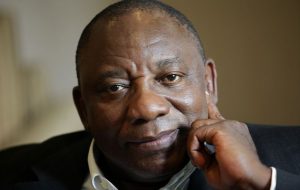


South Africa’s President, Cyril Ramaphosa
By Colleen Goko and Ana Monteiro
SOUTH Africa’s unexpected slump into a second recession in almost a decade has boosted fears of another round of credit-rating downgrades that could see a sell-off in local-currency bonds.
The cost of insuring the country’s debt against default for five years using credit-default swaps spiked to the highest since November 2016 while yields on the government’s benchmark local-currency bonds due in December 2026 rose to an nine-month high.
The rand weakened the most against the dollar among major and emerging-market currencies.
Rand-denominated bonds — which comprise about 90 percent of the country’s liabilities — have the lowest investment-grade rating with a stable outlook at Moody’s Investors Service.
Today’s data could see the company follow S&P Global Ratings and Fitch Ratings Ltd by reducing this to junk, traders including Michelle Wohlberg at FirstRand Bank Ltd said.
The release “has reignited fears of a possible Moody’s downgrade on October 12,” she said.
“Low growth impacts on key revenue streams like tax collection, and given the already high strain on our fiscus, this growth figure is concerning.”
President Cyril Ramaphosa’s ascent to power since December initially boosted confidence and the rand following Jacob Zuma’s corruption-plagued tenure of almost nine years.
That optimism has faded as structural reforms weren’t implemented fast enough and global trade wars and turmoil in other emerging markets soured sentiment. South Africa had been caught in the crossfire of crises in Turkey and Argentina, where currencies have plunged this year.
Moody’s said in March South Africa’s ratings could be placed on negative outlook and eventually downgraded if the government’s commitment or ability to revive economic growth and stabilise debt falters.
Should Moody’s downgrade the local-currency rating, rand debt would fall out of gauges including Citigroup Inc Recession reignites South Africa credit-rating downgrade concern’s World Government Bond Index, and this could see billions of rands of outflows, jeopardising the country’s already-widening budget deficit. The Treasury forecasts a shortfall of 3.6 percent of GDP for 2018/19.
The rand’s slump amid an emerging-market sell-off and higher oil prices drove inflation to a 10-month high in July and the recession news complicates the central bank’s job.
“The South African Reserve Bank faces a major dilemma of whether it should raise rates due to rising inflationary pressure from a weaker currency or refrain from doing so due to very weak economic activity,” said Piotr Matys, a London-based emerging-market strategist Rabobank.
“It’s a close call, but it is reasonable to expect that the overall message will be relatively hawkish” when the bank announces its next decision on September 20, he said.
Finance Minister Nhlanhla Nene will present the government’s mid-term budget on October 24.
The sluggish growth numbers will make his task of convincing investors that the government can maintain spending discipline in the run-up to 2019 elections even harder.
“We think that South Africa still has a stay of execution until after the election nexts year, but that post the election, markets will start to price in a downgrade more explicitly,” said Kim Silberman, analyst FirstRand Ltd’s Rand Merchant Bank unit in Johannesburg. –—Bloomberg